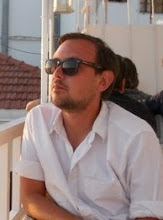
Quentin Tarantino's latest movie, Inglourious Basterds, is in competition at Cannes this week, so I thought I'd post a modified version of an old piece about the director (who I consider to be frightfully overrated):
If you could say that he emerged on the scene with Reservoir Dogs, a heist film that, ingeniously, has almost nothing to do with theft, you could say Quentin Tarantino exploded the scene itself with his second film, Pulp Fiction — hailed by film critics and college stoners ever since as the movie that revitalized American cinema (and, notably, brought John Travolta back to prominence). On the basis of these two films, it would be impossible to deny Tarantino's ability to bring Pop color and violent vitality to the screen: my problem with Tarantino is not necessarily in the fabric of his filmmaking, which has flashes of brilliance beyond its film-buff grandstanding and (sometimes-empty) technical virtuosity, but how flat it leaves me feeling, like a lot of white noise.
Pulp Fiction, the ultimate emblem of his work, is essentially a genre film — his inspiration for the movie's four intertwining stories were the most basic of B-movie archetypes — albeit one thrown into a jittery, colorful blender, composed of bright red blood and L.A. juke joints. Unmeasured, galloping through murders and drug overdoses as most films stroll through romantic parks in autumn, it seethes with a distinctive L.A. energy; it's the kind of the film that seems as though it, like the characters, has done few lines before going out. Pulp Fiction moves along with reckless abandon, never pausing to treat the viewer with narrative kid gloves (or visual and aural ones, for that matter): the jostle of a car, the sharp bleat of a gunshot, a glistening syringe and the firing up of a chainsaw remain gruesomely in the mind long after the credits have rolled.
There are moments, though, where the gimmickry, the inability to maintain steady attention on a single thread or character, becomes tiresome. Maybe I'm too deeply affected by the slime of Tarantino's persona, too put-off by his pot-smoking arcana and the many anecdotes of his crippling pomposity to see any of his movies objectively. But the circularity that many called the best feature of Pulp Fiction, which begins and ends with a robbery at a diner, seems representative of the lack of forward movement in his films, the fugue-like attention to details of fleeting importance to the detriment of real feeling. Pulp Fiction is the zenith of the postmodern, a manic blur of pop cultural deviance chopped up into music video chunks.
It should be no surprise then that my favorite Tarantino films, Jackie Brown and Kill Bill: Vol. 2 are his most searching, not brash and slick but quiet and gritty, like Westerns that, in the lulls between shootouts, enter dim saloons and eavesdrop on the hunted and the hurt and the lonely. The former, with a superb Pam Grier in the lead role, also culls much of its atmosphere from film history, particularly the blaxploitation films of the '70s. But here the debt is sustained, mined for meaning, examined with an eye to updating the genre to include a woman not just "foxy" but witty, darkened by failures of finance and romance, and leavened with a kind of buxom grace.
She, like Uma Thurman in Kill Bill, comports herself delicately but firmly, the kind of woman who kicks ass but charms the pants off you while doing it. Thurman, bird-like, her thin nose framed by perceptive eyes and a tight-lipped mouth, does more ass-kicking than charming in the first volume of Tarantino's kung fu/spaghetti Western opus; the end of the second film, however, with its quiet, painful denouement — she finally kills Bill with a literal flick of the wrist — seems dipped in pathos. Having lost everything and crawled back from the depths (again, literally — at one point she is buried alive, and at another heaves herself from hospital bed to stolen truck), you can feel the ache in her body. Thurman no longer glides but instead stoops a bit, as though lugging a great weight.
At the finale, there is none of the cold self-consciousness that characterizes much of Pulp Fiction, nor the playful cynicism of juxtaposing "Stuck in the Middle with You" with the cutting off of an ear in "Reservoir Dogs." It's just a woman finally confronting the man she once loved, the man who betrayed her, in a silent, moonlit garden. The scene achieves, in its simplicity, in its innocuous and beautiful homage to Western-style vengeance served, the heft of parable. Rosario Dawson described Death Proof as "Reservoir Bitches," but I think you'll have realized by now that Tarantino's bitches don't much interest me, even if the palette is right and the editing smooth, the ironic jokes landed with just the right flat punch. Forgive me for liking my silver screen women to show a little grace.















